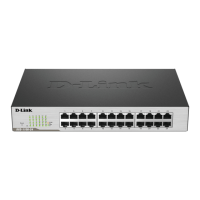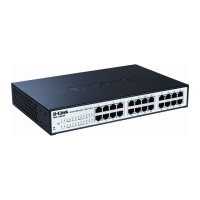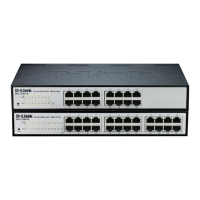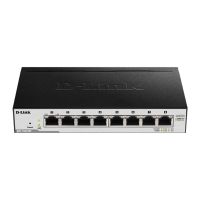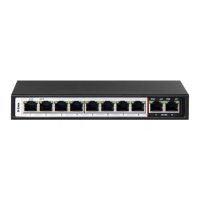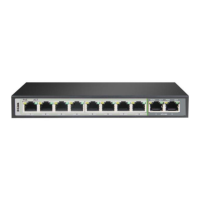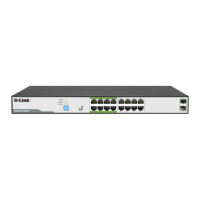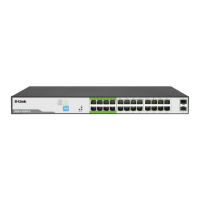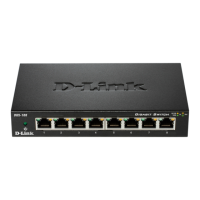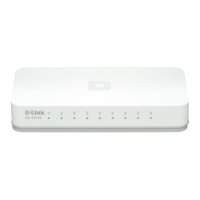Do you have a question about the D-Link EasySmart DGS-1100-08P and is the answer not in the manual?
Explains key terminology used in the manual, differentiating similar terms.
Legal notices regarding intellectual property and usage rights for the manual's content.
Introduces the DGS-1100 series, highlighting its green design and SMB focus.
Details front panel LEDs and rear panel connectors for the 5-port model.
Details front panel LEDs and rear panel connectors for the 8-port PoE model.
Details front panel LEDs and rear panel connectors for the 16-port model.
Details front panel LEDs and rear panel connectors for the 24-port model.
Lists essential items included in the shipping carton for various DGS-1100 models.
Covers desktop, shelf, rack, and wall-mount installation procedures for safe operation.
Instructions for connecting the AC power cord and grounding the switch for safe operation.
Introduces Web-based Management and SmartConsole Utility for switch configuration.
Steps to connect to the switch and access its web interface for configuration.
Instructions for installing and launching the SmartConsole Utility on a PC.
Details on accessing the web interface using the factory default IP and password.
Configuration of utility settings, log, trap, monitor list, and about information.
Covers device settings, password management, firmware upgrade, DHCP refresh, and web access.
Adding, deleting, and discovering devices on the network using the utility.
Overview of the main screen areas: Tool Bar, Function Tree, and Main Configuration Screen.
Configuration of IP, system name, location, and login timeout settings.
Adjusting port speed, duplex, flow control, and configuring trap settings for SmartConsole.
Setting up password protection and enabling Jumbo Frame support for enhanced throughput.
Configuring port trunking for increased bandwidth and IGMP snooping for multicast traffic.
Monitoring network traffic via port mirroring and preventing network loops with loopback detection.
Viewing port statistics and diagnosing copper cable quality for network troubleshooting.
Setting up VLANs, including 802.1Q, PVID, and VLAN naming for network segmentation.
Configuring management VLAN access and assigning ports to specific VLANs based on their type.
Prioritizing surveillance and voice traffic using dedicated VLANs for quality and security.
Segmenting traffic flow and configuring 802.1p priority for Quality of Service.
Managing network storms and controlling bandwidth allocation for ports.
Configuring static MAC address entries and managing the dynamic forwarding table.
Configuring overall Power over Ethernet settings, including power budget and status.
Managing individual port PoE states, priority, power limits, and user-defined settings.
Explains Gigabit Ethernet, its advantages over previous standards, and applications.
Discusses the importance and evolution of Fast Ethernet from 10Mbps standards.
Describes how switching technology increases network capacity and divides LAN segments.
Details switching capacity, forwarding rates, memory, physical, and environmental parameters.
Lists EMI/Safety certifications and key features like L2, VLAN, QoS, Management, and Power Saving.
Safety instructions for installing equipment in a rack, covering ambient temperature and airflow.
| Ports | 8 x 10/100/1000BASE-T |
|---|---|
| PoE Ports | 8 |
| PoE Standard | IEEE 802.3af/at |
| PoE Budget | 64 W |
| Switching Capacity | 16 Gbps |
| Forwarding Rate | 11.9 Mpps |
| MAC Address Table | 8K |
| Jumbo Frame | 9216 bytes |
| Switch Type | Managed |
| VLAN Support | Yes |
| Quality of Service (QoS) | Yes |
| IGMP Snooping | Yes |
| Power Input | 100-240V AC, 50/60Hz |
| Operating Temperature | 0 to 40 °C (32 to 104 °F) |
| Storage Temperature | -10 to 70 °C |

